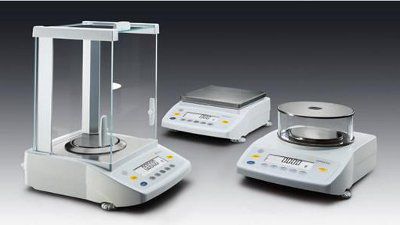Analyzer Scale
What is an electronic analytical balance?
Electronic analytical balances are a type of electronic balance designed to weigh very small samples with high accuracy, usually in the sub-milligram range. In addition to weighing capabilities, this device also integrates the function of drying and analyzing the moisture content of the sample. In terms of structure, most modern analytical balances on the market consist of two main parts: the weighing chamber and the display screen. Furthermore, they are capable of connecting to a computer system to manage weighing data.
Weighing chamber: The outside is made of glass to prevent wind and avoid affecting the weighing results.
Display screen: This is where the weighing results are displayed along with the control function buttons.
How many types of electronic analytical scales are there?
Currently, electronic analytical scales have been classified based on accuracy, providing many options suitable for specific measurement needs. Below are the types of scales classified by accuracy:
1. 1-Digit Analytical Balance:
- This is a scale line with the ability to weigh with an error of: 0.1g.
- Suitable for basic measurement applications and do not require high accuracy.
2. 2-Digit Analytical Balance:
- This balance has a weighing capacity of 0.01g.
- It is a suitable choice for applications requiring medium precision, such as basic chemical analysis.
3. 3-Digit Analytical Balance:
- Designed for higher precision measurements, with a precision of 0.001g.
- Suitable for research and experimental applications requiring precise accuracy.
4. 4-Digit Analytical Balance:
- Weighing with the highest precision, with an error of only 0.0001g.
- For applications requiring very high precision such as in the pharmaceutical or quality industry.
5. 5-Digit Analytical Balance:
- This is a line of scales with excellent precision, with an error of only 0.00001g.
- Suitable for applications requiring extremely high precision, such as quality research and analysis of complex compounds.
Some frequently asked questions:

What can electronic analytical balances be used for?
- Electronic analytical balances are suitable for accurately measuring the mass of small samples in fields such as chemistry, pharmacy, and scientific research.
How to maintain and calibrate analytical balances?
- Maintain and calibrate according to the manufacturer's instructions to ensure the accuracy and reliability of the balance.
Is it necessary to connect the analytical balance to a computer?
- Connecting to a computer makes it convenient to manage and store measurement data, but it is not mandatory.
How to prevent the influence of wind on weighing results?
- The weighing chamber is made of glass to prevent wind and ensure accurate weighing results.
Can electronic analytical balances be used in harsh environmental conditions?
- Some models are designed to withstand harsh environmental conditions, however, it is advisable to check the specifications of each model to ensure suitability.
Electronic Analytical Balances and Applications:
With their high accuracy, electronic analytical balances are ideal for measuring the mass of small and valuable samples. Their versatile applications make them an important tool in many fields, including laboratories, weighing gold and silver, and research institutes that require high precision.
Advantages and Applications:
- Industries such as petrochemical, biochemical, and pharmaceutical rely on this line of scales to ensure that production processes are carried out with high precision and quality control.
- In the field of gems and precious metals, electronic analytical balances are indispensable tools for measuring small but valuable quantities of gold, silver, and precious stones.
- The accuracy and sensitivity of electronic analytical balances make them a staple in laboratories and research institutes where precise measurements are required to ensure reliable research results.
Notes when using electronic analytical scales
- Place the scale on a flat, unsteady surface and avoid unwanted vibrations, helping to maintain stability during the measurement process.
- Turn on the scale 15-20 minutes before starting to use so that the scale has enough time to warm up and reach a stable state.
- The center of the scale pan is the ideal place to place the weighed object, helping the scale to measure accurately and evenly.
- Avoid weighing beyond the maximum load of the scale to protect the sensor and ensure the accuracy of the results.
- When weighing chemicals, avoid pouring directly onto the scale. Use a chemical container to ensure safety and protect the scale from the effects of chemicals.
- Clean the scale regularly after each use to ensure cleanliness. This not only keeps the scale working efficiently but also prolongs its life.
- When not in use, turn off the power source of the scale completely to save energy and maintain the equipment.
- Follow the operating environment as instructed to ensure that the scale operates in ideal conditions and is not affected by external factors.
- Use the power source according to the supplier's instructions to avoid power-related problems.
- Perform periodic calibration and verification procedures to ensure that the scale operates with high accuracy and maintains reliability over long periods of time.
-
-
-
-
-
-
-
-
-
-
-
-
-
-
-
-
-
-
-
-
-
-
-
-